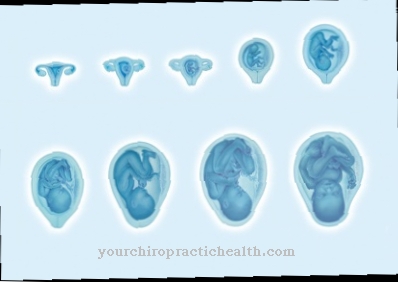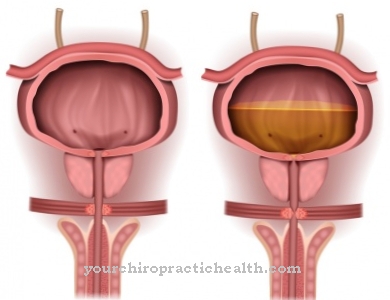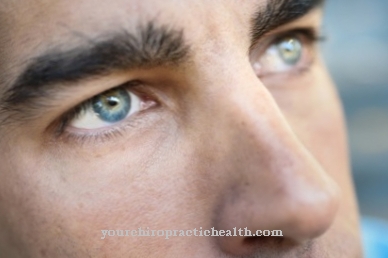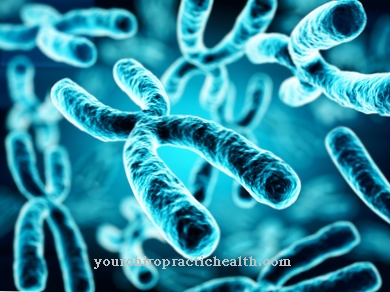The Canine guidance is part of the occlusion (closure, closure), the contact between the teeth of the lower and upper row of teeth. The canines form the slideway for the antagonistic (opposite) teeth and guide the lower jaw, while there is no contact between the posterior teeth.
What is the canine guide?

If the canine tooth guidance also exists with the premolars (premolar teeth), dentists speak of a premolar guidance. The English expression is a synonym for canine guidance canine guidance. The guide is created between the canine teeth of the lower and upper jaw.
If the closed rows of teeth are in the resting position, the upper and lower molars (molars) on one side of the jaw touch. In the case of lateral chewing movements, the distance between the two rows of teeth is inevitable because the upper and lower canines touch each other due to their size. The canines thus represent an obstacle that separates the rows of teeth.
Function & task
If the chewing apparatus functions properly, the tooth and temporomandibular joint structures are harmoniously coordinated. The interlocking of the upper and lower jaw is optimal, the temporomandibular joints are centrically aligned, the masticatory muscles show maximum relaxation when in a resting position. The entire biomechanics are therefore consistent.
The temporomandibular joint is the most complex movement system in the human body, as it performs three-dimensional spatial movements. The canine guidance is part of this movement system, which creates an interaction between the jaw joints, chewing surfaces, masseter muscles and the function of the masticatory muscles. The term canine external position (canine raised position) describes the position of the canine teeth outside the row of teeth. When dentists speak of low canine teeth, they mean the wrongly positioned canines outside the row of teeth.
The canines play an important leadership role in the dynamic chewing function. With permanent dentures such as dental bridges or crowns, an occlusion concept is important that also aims to restore the canine guidance.
However, full dentures or full dentures are a contraindication for creating the canine guidance. A point-like contact between the dental prosthesis of the lower or upper jaw or their canine teeth would tip a full denture in the case of canine guidance. In contrast to the previously existing anatomical occlusion situation, simultaneous guidance of all teeth (molars, canines, premolars) on one side is the prerequisite for stable chewing function. Therefore, the canine guide must be eliminated in the case of a total implant.
You can find your medication here
➔ Medication for toothacheIllnesses & ailments
If there is a bite or occlusion disorder in the temporomandibular joints and the masticatory muscles, dentists speak of a myoarthropathy. A disorder in the temporomandibular joints is known as arthropathy. Myopathy is when the masticatory muscles are disturbed. These clinical pictures occur through functional disorders in the form of incorrect contacts. Synonyms are craniomandibular dysfunction (CMD) and temporomandibular joint syndrome.
If the interaction of the teeth is disturbed, this leads to an overloaded masticatory muscles and disharmonious tooth contacts with unnatural wear and tear of the chewing surfaces. The temporomandibular joints are then overused. Psychoemotional stress can also lead to tension in the face, jaw and head muscles and thus to incorrect contact between the teeth.
The functional diagnosis and anamnesis with a description of the pain quality lead to the therapy concept against pain in the temporomandibular joint, because misaligned teeth can not only cause discomfort in the jaw area, but also affect other parts of the body such as the head, ears and spine. The ideal way of diagnosis and therapy is therefore in interdisciplinary cooperation with other specialists such as physiotherapists, orthopedists and osteopaths. The aim is to restore a correct bite position and relaxed jaw muscles. These holistic complaints are often caused by misaligned teeth, damaged dentures or gnashed teeth.
Grinded side and canine teeth, which are caused by pressing the jaw and grinding teeth (bruxism), can be restored with little effort. The lost tooth substance is connected to the tooth substance by means of ceramic table tops and composite add-ons by means of a minimally invasive procedure through biological cross-linking (adhesive technique). The physiological bite height is restored. Composite table tops can be removed at any time and replaced with a definitive reconstruction technique using ceramics when a corrected bite position has been reached.
In contrast to the use of crowns, this reconstruction prevents a high amount of substance removal. The reconstruction treatment is usually more effective than the therapy with a removable splint, which is worn as a protective splint at night to protect against tooth abrasion during sleep. However, it does not fight the causes, because misalignment, abrasion, bite and occlusion disorders remain.
In most of these cases there is no functioning canine anterior guidance. The occlusal plane is lowered and the pressure on the teeth increases. A bite disorder not only affects the jaw area, but can also lead to complaints of the musculoskeletal system. This manifests itself in pain in the hip and knee joints, in the spine as well as in the neck, arm and shoulder area.























.jpg)



